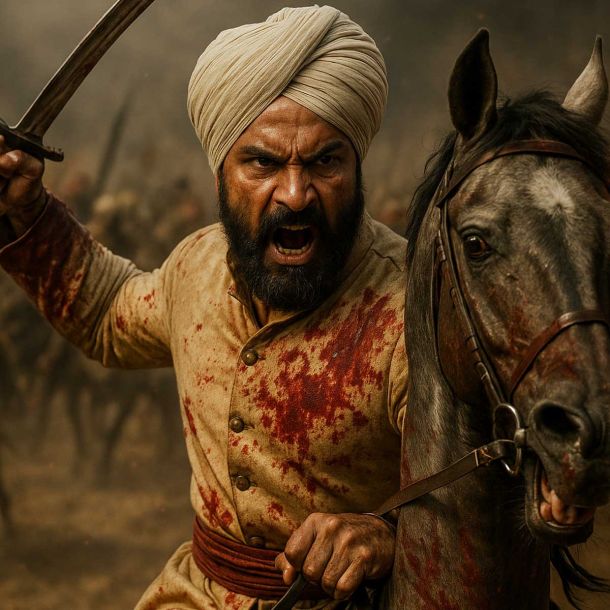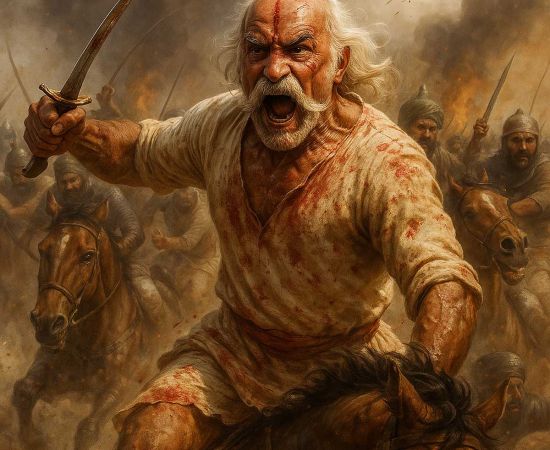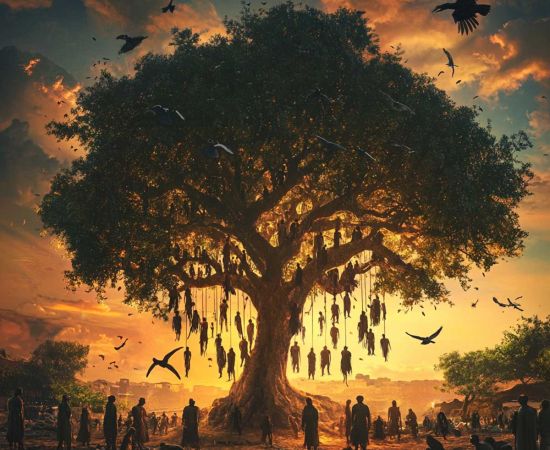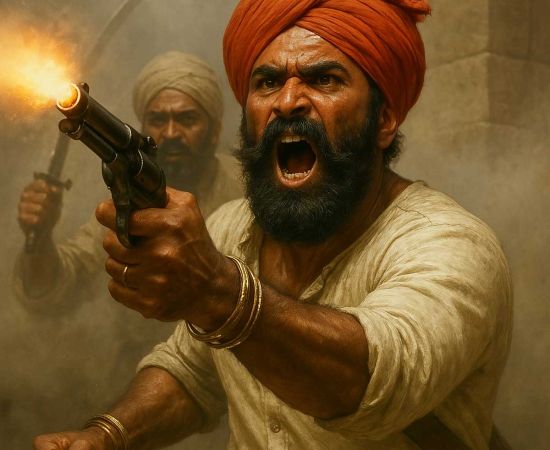MORE COVERAGE
Twitter Coverage
Satyaagrah
Written on
Satyaagrah
Written on
Satyaagrah
Written on
Satyaagrah
Written on
Satyaagrah
Written on
JOIN SATYAAGRAH SOCIAL MEDIA
Islamists have long employed violence as a strategic tool of contention to exact obedience, assert their hegemony, and silence their critics: Here’s what Islamists have achieved with their veto on street violence

Islamists have long employed violence as a strategic tool of contention to exact obedience, assert their hegemony, and silence their critics. More so with street violence, which they have monopolized by institutionalizing thuggery over decades, or perhaps centuries, to prevent a critical assessment of their religious dogmas and immutable convictions.
For instance, when former BJP spokesperson Nupur Sharma made remarks on Prophet Muhammad derived from Islamic Hadiths, the Islamists felt no qualms in leveraging their metier—street violence—to wreak havoc in cities and towns across the country with complete abandon.
Thousands came out on the streets, not just to oppose Nupur Sharma’s comments on Prophet Muhammad and hurl death threats at her, but to demonstrate the disproportionate hold their community enjoys over violence to instill fear among critics and pressurize the government into eating out of their hands.
Cities and towns across the country were burning with the fire of Islamic radicalism as Islamists went on a rampage, wantonly indulging in violence, vandalism, and arson for what they considered an insult to Prophet Muhammad. The attacks resulted in deaths and injuries, caused huge losses to the public exchequer, and created an atmosphere of fear and terror, precisely what the Islamists wanted to discourage ‘Kafirs’ or idolators from weighing in on their religious beliefs and scriptures.
For Islamists, having an open discussion of the teachings of Islam or the life of Prophet Muhammad is a strict no-go zone. While the public scrutiny of the Islamic religious texts has attracted intellectual opposition from ideological enablers of Islamists and left-liberals, it has also drawn crude reprisals in the form of violence and intimidation from extremists, as evident in the Nupur Sharma case.
Anyone who speaks against Islam or broaches the topic of Prophet Muhammad has to face severe backlash from Islamists, who are perpetually itching to use street violence against ‘Kafirs’, often manufacturing ‘provocation’ to justify their resort to violence. For them, Islam is inviolable, and their Prophet is unimpeachable. Those who do not conform to this worldview are regarded as a fair game, a reasonable and justifiable target to unleash their fury of street violence under the pretext of seeking instance ‘justice’ over perceived infractions.
While one might be inclined to dismiss the repeated use of street violence as an attribute intrinsic to the community, the ramifications are not just limited to the realm of law and order and extend well into the country’s political systems. Besides stamping their authority and seeking instant gratification from taking to street violence, the larger aim of the Islamists in employing violence as a strategic tool is to hold the government of the day to ransom, bend them to their will and push toward their fantasy of supplanting the secular democracy with a Sharia-compliant government.
And they have been quite successful in coercing governments and authorities into doing their bidding by the sheer use of unrestrained force and wanton violence. Over the years, they have mastered and honed the skill of leveraging this veto of violence to suppress any attempts at public scrutiny of Islamic tenets and chipping away at India’s millennia-old pluralistic culture and civilizational ethos.
For centuries, India was the epitome of multicultural co-existence, where people of different faiths, value systems, and beliefs lived in peace and harmony. It continues to remain as one, but its character endured an indelible change after the Islamic marauders and later, the British, cast their evil eyes on it.
The arrival of Islamic invaders on the Indian shores brought in its wake the primitive culture of the nomadic tribes that did not flinch from using violence as an instrument of repression against the ‘Kafirs’ and non-believers. Hindus, Jains, Buddhists, and people of other faith were oppressed, persecuted, and killed because they refused to abandon their faith and embrace Islam.
The strife between Hindus and Muslims continued for much of India’s history as Muslim rulers slaughtered Hindus, demolished their places of worship, and took their women as war exploits. The British, in their desire to establish control over the subcontinent, fuelled the divide between Hindus and Muslims. But over the last century, Islamists have cunningly used the veto over street violence to make significant gains and reinforce their political and social might.
 |
Insertion of Section 295A in the Indian Penal Code
Though Islamists had long mastered the use of street violence to push through their demands and gain concessions from the prevailing government, their first substantial achievement came with the inclusion of Section 295A in the Indian Penal Code. Section 295A deals with deliberate and malicious acts intended to outrage religious feelings of any class by insulting its religion or religious beliefs.
The genealogy of Section 295A has its roots in 1927 when a book called ‘Rangeela Rasool’ was published in response to continuous provocation by the Islamists mocking Hindu Gods and Goddesses. Hindus, who refused to take the insult of their faith lying down, decided to give Islamists back in the same coin. They launched a pamphlet titled ‘Rangeela Rasool’, a satirical take on the domestic life of Mohammed.
The pamphlet elicited a sharp reaction from the minority community of then undivided India on the grounds that it allegedly contained demeaning passages about the founder of the Islamic faith. The opposition to the pamphlet swelled and metamorphosed into widespread protests, with Islamists at the time hitting the streets and demanding the arrest of its author and the publisher. Mahashay Rajpal, the publisher, was initially arrested but was later acquitted by the court.
This naturally raised the hackles of the Islamists who have been demanding capital punishment for him for having hurt their ‘religious sentiments’. In several places, riots broke out after provocative speeches given by religious leaders. Al-Jamiat an official arm of the Jamiat-Ulaima-i-Hind warned in an article that “under sharia the punishment for insulting the prophet is death and it is legally permissible to kill those who insult the prophet”.
The street protests and demonstrations witnessed after Rajpal’s acquittal forced the British Government of the day to enact a specific law against causing insult to religious feelings, resulting in the insertion of Section 295A in the Indian Penal Code in 1927. However, despite winning the concession in the form of the inclusion of Section 295A in the IPC, Islamists remained resentful toward Mahashay Rajpal, for ‘Ghustake Rasool ki Ek hi saza, sar tan se juda’, and two years later, in 1929, a 19-year-old Islamist named Ilm ud din stabbed him to death.
Partition of India
The partition of India was another bloody chapter when Islamists, who by the sheer use of violence and their capability to incite anti-Hindu riots, were able to vivisect the country into two—India and Pakistan—on the religious grounds. Years before India’s independence, the Muslim League, the party that pioneered the two-nation theory, mobilized radical Muslims by promising them an Islamic country governed by Sharia.
Intoxicated by the dream of a separate nation, Islamists rallied behind the Muslim League, giving it a fresh lease of life against the much more robust and pervasive Congress party. India’s partition and the creation of Pakistan became a rallying cry for the radical Muslims, who already harboured a deep aversion to living in a Hindu-majority country and adhering to the prevalent syncretic ethos of the society.
However, when the Congress party rejected India’s partition as demanded by the Muslim League, thousands and lakhs of Islamists across the country came out on the streets to exercise their veto of violence, indulging in riots, violence, and vandalism over their demand for the creation of Pakistan. With the Congress party wary of responding to the Islamists in the language they understand for fear of losing its popularity among Muslims, it cravenly capitulated to the street violence of Islamists and agreed to the partition of India.
 |
Salman Rushdie forced into hiding over Satanic Verses
In 1989, author Salman Rushdie’s ‘The Satanic Verses’ stirred massive controversy after outrage swept among the Muslim community over the content of the book that they said was blasphemous. Muslim critics of ‘The Satanic Verses’ accused Rushdie of portraying Islam as a “deceitful, ignorant, and sexually deviant religion”, sparking transnational uproar and widespread protest from the Muslim community.
India, with one of the largest Muslim populations in the world, was also affected by the ripples caused by Rushdie’s The Satanic Verses. Giving in to the Islamists, India, which preened itself on being a bastion of democracy and free speech, became one of the first countries in the world to ban The Satanic Verses. The Home Ministry of India had then recommended Rajiv Gandhi-led Congress government that the publication and sale of the said book could cause a riots-like situation in India, advising it to ban the book to maintain communal harmony in the country.
The Home Ministry anticipated violent reaction from the Muslim community over ‘The Satanic Verses’ and preempted them by recommending the Centre on banning the book. The Rajiv Gandhi government accepted Home Ministry’s recommendation and announced a ban on the book, months before the Ayatollah Ruhollah Khomeini of Iran issued a fatwa ordering Muslims to kill Rushdie. Even ‘moderate Muslims’ within the Congress party such as former Union Minister Salman Khurshid, who is an Oxford graduate, justified and defended the ban on the book.
The episode underscored the Indian government’s cowardly surrender to the rioting Islamists, fearing whom it deemed acceptable to ban a book without proper scrutiny, as alleged by Salman Rushdie years later. In his memoir, Joseph Anton, Rushdie writes that The Satanic Verses “was not examined by any properly authorized body, nor was there any semblance of the judicial process”, before the Indian ban was enacted, and that “the ban came, improbably enough, from the finance ministry, under section 11 of the Customs Act, which prevented the book from being imported.”
Several Islamic nations undid the initial ban on the book, but India continued to enforce the ban, fearful that the removal of the ban could trigger Islamist violence, ultimately forcing the government into imposing the ban again. Nevertheless, the entire episode underlined the shocking pusillanimity of the Indian government by allowing radical extremists to influence its decisions and undermine its longstanding commitment to freedom of speech and secularism.
Rajiv Gandhi-led government surrenders to Muslim hardliners to overturn the SC judgment in the Shah Bano case
In 1986, the Indian state headed by Rajiv Gandhi set a dangerous precedent of capitulating to Muslim hardliners. The Mohd. Ahmad Khan vs. Shah Bano Begum & Others case and the subsequent legislation passed by the Rajiv Gandhi government in 1986 are often remembered as pivotal moments in India’s political history.
It all started when Shah Bano, the 62-year-old Muslim woman, filed a petition in court in April 1978 demanding maintenance from her divorced husband Mohammed Ahmad Khan, a renowned lawyer in Indore, Madhya Pradesh. Shah Bano’s husband Khan divorced her by uttering triple talaq later in November stating he was not obliged to pay her any maintenance as she is not his wife under Islamic law.
The two were married in 1932 and had five children — three sons and two daughters. Shah Bano’s husband had forced her to move out of the residence three years before, after living with Khan and his second wife.
Shah Bano, who went to court against her husband, filed a claim for maintenance for herself and her five children under Section 123 of the Code of Criminal Procedure, 1973. In August 1979, Shah Bano won the maintenance case in the local court, which ordered Khan to provide her with the maintenance of Rs 25 per month. However, Khan contested the claim on the grounds that the Muslim Personal Law in India required the husband to only provide maintenance for the iddat period after divorce.
Years later, Shah Bano filed another plea seeking revised maintenance in Madhya Pradesh High Court. In April 1985, in a historic judgment, the Supreme Court ruled in favour of Shah Bano and upheld the decision by the High Court stating that she was entitled to be paid for maintenance by her husband.
Islamists, having commanded the art of using street violence to their advantage once again pulled the arrow of violence and intimidation out of their quiver. Large-scale protests were launched, with Muslim fundamentalists describing the judgment as an attempt to undermine the Muslim Personal Law. The Muslim hardliners and clerics pushed the then Rajiv Gandhi government, elected in 1984, to pass the Muslim Women (Protection on Divorce Act), 1986. This law overturned the Supreme Court’s verdict in the Shah Bano case. The 1986 Muslim Women (Protection on Rights of Divorce) Act diluted the Supreme Court judgment and allowed maintenance to a divorced woman only during the period of iddat, or till 90 days after the divorce.
The Muslim Women Act in 1986, virtually pitted women’s individual rights against the rights of a religious group and the latter with their street veto power were capable of enforcing the law over a weak, minority appeasing government led by Rajiv Gandhi.
 |
Narasimha Rao’s government buckled under the pressure of Islamic radicals; enacted the Places of Worship Act of 1991, to prevent Ram Janmabhoomi-like movements in future
The Ram Janmabhoomi movement in the late 1980s and early 90s was married with violence and riots as the Muslim fundamentalists took to the streets to oppose the Hindu side’s demand for the reclamation of the disputed site of the Babri structure, where they said a Ram temple existed before Mughals brought it down.
As the Ram Janmabhoomi movement was at its peak, the Islamists once again resorted to deploying violence as a strategic tool to pressurize the government into granting them concessions. Consequently, the Narasimha Rao govt at the center brought a new law with a motive to prevent Ram Janmabhoomi-like reclamation movements by Hindus in India. This law was the Places of Worship (Special Provisions) Act 1991.
The statement of objects and reasons of this act reads as, ‘An Act to prohibit conversion of any place of worship and to provide for the maintenance of the religious character of any place of worship as it existed on the 15th day of August 1947, and for matters connected therewith or incidental thereto’.
The act declares that the character of a place of worship freezes on 15 August 1947, meaning if a place of worship is a mosque as on 15 August 1947, its character is that of a mosque even if it was originally a temple. The act provides for punishment if any person changes or attempts to change the character of any place of worship of one religious denomination or section thereof into another section of the same denomination or other.
The act provides for abatement of any suits or proceedings in any courts in the country relating to disputes about the character of places of worship already pending at the time of commencement of this act. The act also prohibits any suits or proceedings that may be instituted after the commencement of this act. Ram Janmabhoomi's dispute had been excluded from the purview of this act.
Thus, with the veto of street violence, Islamists were able to secure favourable legislation from the government to ensure that there could be no Ram Janmabhoomi-like movement in the future to reclaim other occupied Hindu religious sites. Apparently, when a Shivling was discovered inside the wuzukhana of the Gyanvapi mosque, the Islamists resorted to citing provisions of the Places of Worship Act, 1991 to prevent Hindus from reclaiming their religious sites, stating that the Act says a site of worship’s religious character must remain the same as it was on August 15, 1947.
References:
opindia.com - Jinit Jain
 Support Us
Support Us
Satyagraha was born from the heart of our land, with an undying aim to unveil the true essence of Bharat. It seeks to illuminate the hidden tales of our valiant freedom fighters and the rich chronicles that haven't yet sung their complete melody in the mainstream.
While platforms like NDTV and 'The Wire' effortlessly garner funds under the banner of safeguarding democracy, we at Satyagraha walk a different path. Our strength and resonance come from you. In this journey to weave a stronger Bharat, every little contribution amplifies our voice. Let's come together, contribute as you can, and champion the true spirit of our nation.
 |  |  |
| ICICI Bank of Satyaagrah | Razorpay Bank of Satyaagrah | PayPal Bank of Satyaagrah - For International Payments |
If all above doesn't work, then try the LINK below:
Please share the article on other platforms
DISCLAIMER: The author is solely responsible for the views expressed in this article. The author carries the responsibility for citing and/or licensing of images utilized within the text. The website also frequently uses non-commercial images for representational purposes only in line with the article. We are not responsible for the authenticity of such images. If some images have a copyright issue, we request the person/entity to contact us at satyaagrahindia@gmail.com and we will take the necessary actions to resolve the issue.
Related Articles
- Stone pelting from the rooftops on Hanuman Jayanti procession in Jahangirpuri, police vehicles torched, used firearms to attack police: Ambush on Hindu holy expedition continues in the country, one policeman shot
- NDMC to bulldoze “illegal encroachments” in Delhi's Jahangirpuri where riots broke out against Hindu devotees: Tukde tukde gang supporter AAP’s Amanatulah Khan says ‘attempt to disrupt peace during Ramzan’
- Violent protests broke out by Islamists in Jharkhand capital of Ranchi over the alleged ‘blasphemous’ comments by Nupur Sharma, as per police the protests gathered pace after Friday Namaz
- Sleeper cell module was activated in pre-planned violence to establish dominance of Muslim community so Hindus don't dare to take out Shobha Yatras in future: Stones collected and kept on route of yatra ahead of time
- 'Anti-Hindu Delhi riot was remotely supervised by Umar Khalid just like 9/11 conspirators,’ prosecutors oppose Khalid’s bail plea, says 'Riot key conspirators were like entertainers who resorted to damrubaazi to attract crowd'
- Standing atop police commissioner’s car Maulana Wasim Mobalik instigated a Muslim mob through provocative speech culminating in attacks on the police station, temple, and hospital in Hubballi: Karnataka
- ‘Stone pelters and the rioters will be greeted with bulldozers. Houses damaged in Khargone violence will be rebuilt and rioters will be made to pay the price of construction’: Shivraj Singh Chouhan, MP
- 16-year-old Shivam has regained consciousness after five days in coma, he and his family took part in the Ram Navami celebration in Khargone when Islamists attacked: He had sustained significant brain damage
- Left-liberal journalists attempt to whitewash Islamists' attack on Hanuman Jayanti procession of Hindus fall flat after Viral video shows the moment when the Shobha yatra was attacked first near a mosque in Jahangirpuri
- ‘Sarkar ko Jhukana and, Hindu-musalman karwana hai… Need to finish Hindus, make a separate nation for Muslims’: Govt counsel continues to present scathing evidence to oppose bail to Umar Khalid
- Jodhpur witnesses rampant violence on Eid as mob goes on a rampage after Namaz: Muslim mob replaced Bhagwa flag with an Islamic flag at Jalori intersection
- Shaikh Abrar Shaikh Jamil alias Shahrukh was taken into custody after 31 swords and a khukri was recovered by the police, had ordered massive quantities of swords and khukris online using a fake ID: Aurangabad, Maharashtra
- Bulldozer out to teach a lesson to criminals, rioters who create unrest in the society: Razed off all the shops near the dargah in Khambhat where stone-pelting took place on the chariots in Rath Yatra procession, Gujarat
- "Hindus were attacked but nobody came to rescue us, what's wrong with chanting 'Jai Shri Ram? Do we stay in Pakistan": Suresh Sarkar who created chariot for Jahangirpuri procession and was detained
- As Hindus across the world celebrate Ram Navami, in India Islamists unleash mayhem in 5 Indian states to stop Hindu processions, engaged in stone-pelting, targeted attacks, arson, violence, and vandalism: Not a new phenomenon in India



























